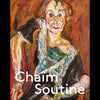Chaïm Soutine Against the Current
Pressedownload
Der Pressedownload darf nur im Zusammenhang mit einer Buchbesprechung verwendet werden. Für die Illustration einer Buchbesprechung können nur bis zu drei Bilder genutzt werden. Für andere Textformate und Nutzungszwecke (wissenschaftliche Vorträge, Werbung oder ähnliches) bitten wir Sie, vorab mit uns in Kontakt zu treten, um mögliche Fragen zu Honorarkosten, Nutzungsund Urheberrechten zu klären. Die bereitgestellten Bilddaten dürfen nicht manipuliert, beschnitten oder zweckentfremdet verwendet werden. Die Pressebilder dürfen nur mit dem vollständigen Bildtitel, dem Namen des Künstlers und/oder Urhebers sowie mit dem Hinweis auf den Hatje Cantz Verlag veröffentlicht werden. Bitte beachten Sie außerdem im Einzelfall die Reproduktionsbedingungen der VG Bild-Kunst Bonn bzw. der internationalen Verwertungsgesellschaften für Bildende Kunst.
Chaïm Soutine
Clenched, raw and pressingly urgent: Chaïm Soutine’s vivid paintings are testimonies to a sense of human vulnerability and an existence on the margins of society. Intensely colored, his meaty impasto portraits are thrown onto the canvas with broad brushstrokes, while his agitated, frenetic landscapes and paintings of slaughtered animals are expressions of an intense hunger for life and, at the same time, a deep alienation in an unsteady world that offers no support. Despite the recognition his work received, Soutine remained an outsider throughout his life, a stranger to the social manners of his adopted home in France. This catalogue focuses on the early masterpieces and series he created between 1919 and 1925: Under the overarching theme of emigration and uprooting, the contributions reveal the traces of Soutine’s Jewish origins in his work, illuminating the significance of his motifs from the fringes of society as well as of blood and animal carcasses as metaphors; and show the influences of Soutine’s art up to the present day.
This book is also available in German.
CHAÏM SOUTINE (1893 – 1943) grew up in a shtetl near Minsk – a youth marked by poverty, religious rigor and social exclusion. In 1913 he arrived in Paris and moved into the artist residence “La Ruche” (the “Beehive”), working alongside artists such as Chagall and Modigliani. Fleeing the Nazis, he died in 1943, but the international attention his work had received since the 1920s continued to have great influence on post-war art, inspiring Abstract Expressionism, new figurative painting as well as contemporary artists.
Kunstsammlung Nordrhein-Westfalen, K20, Düsseldorf
September 2, 2023 – January 14, 2024
Louisiana Museum of Modern Art, Copenhagen
February 10 – June 16, 2024
Kunstmuseum Bern
August 16 – December 1,2024





















